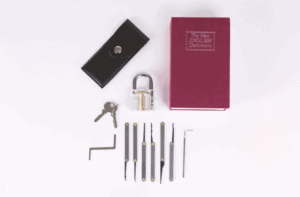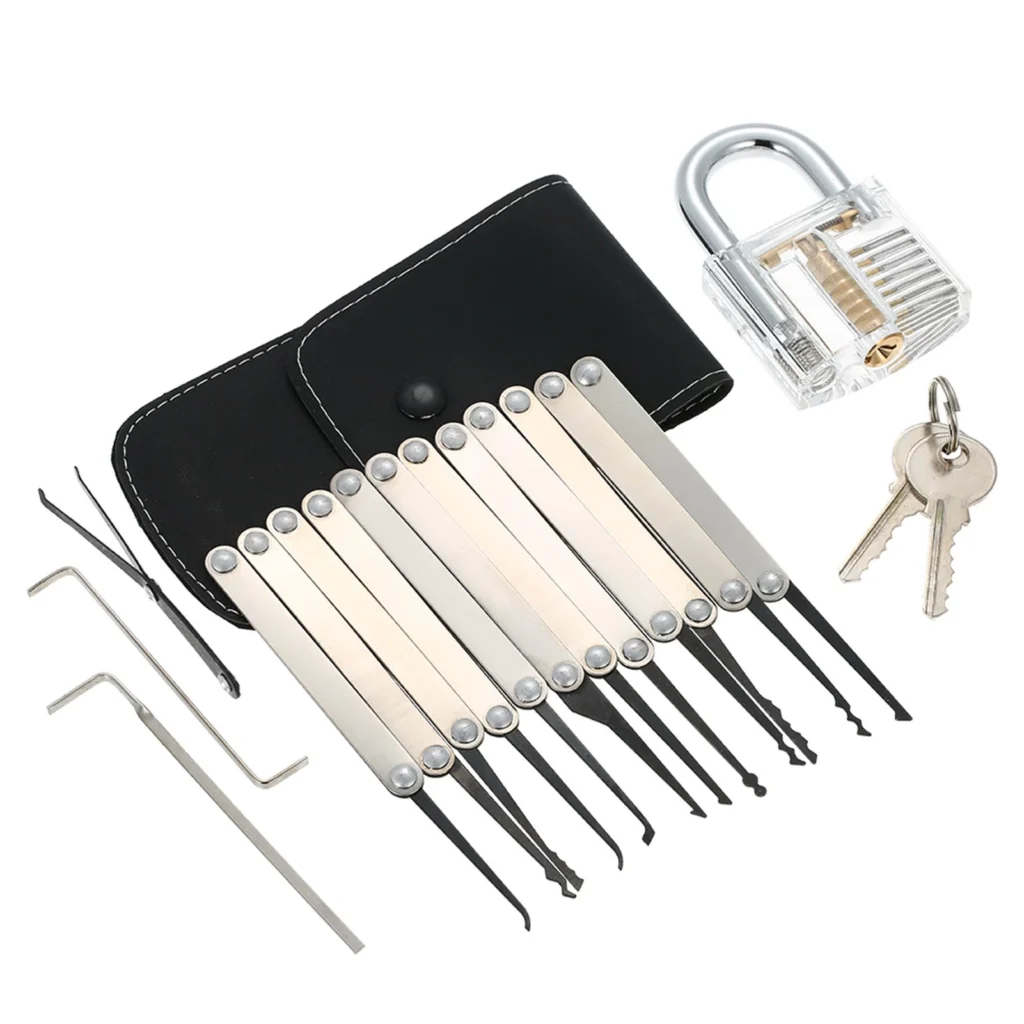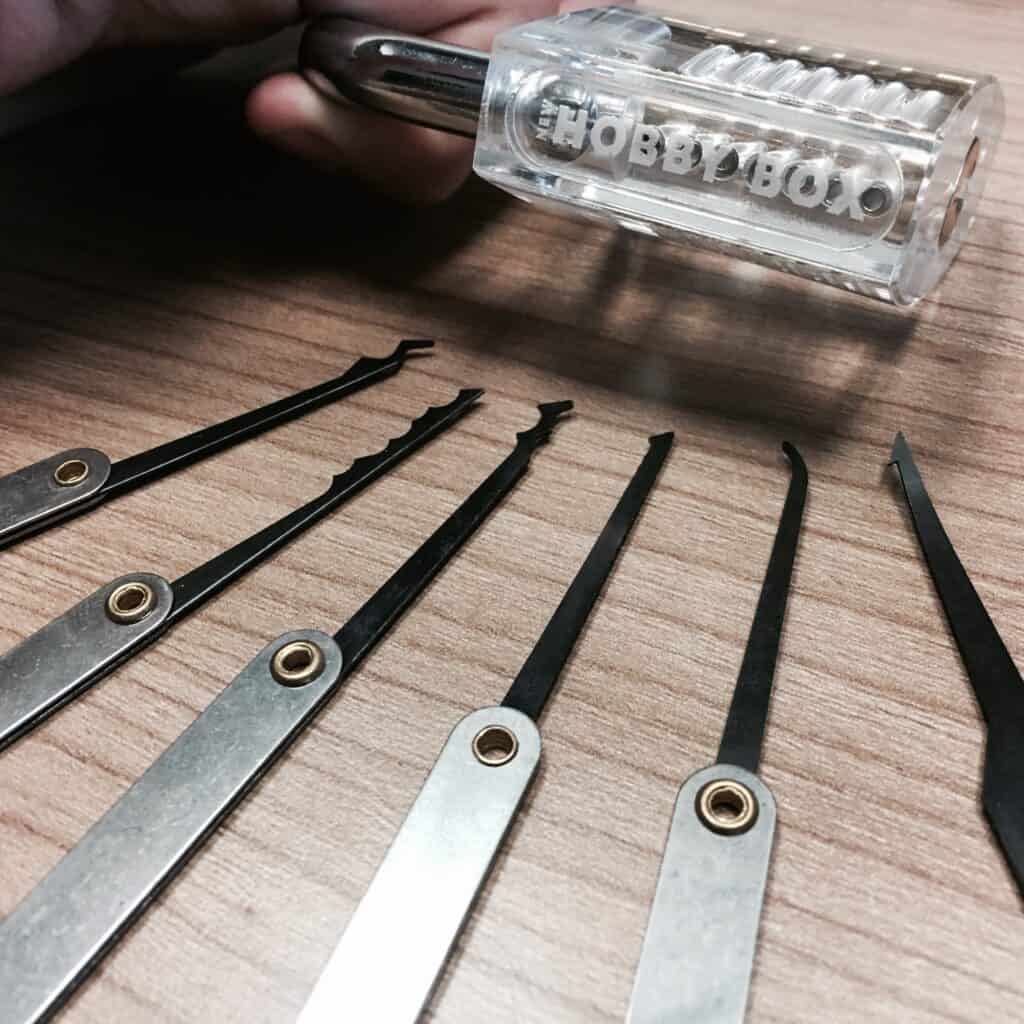
This might be the first time I’ve had to slap a disclaimer on a how-to guide. But it’s an important one. Because learning how to pick a lock comes with quite a bit of responsibility. So before we start, I just want to make sure everyone is clear that this guide is for hobby purposes only. Don’t go picking locks you aren’t supposed to, OK?
Now that we’ve got that out of the way, let’s talk about how to pick a lock – more specifically, lockpicking for beginners!
Sure, lock picking is an essential skill for anyone looking to increase their security, but it’s also a fun puzzle. And if you are looking for an always challenging puzzle, this is a solid hobby for you.
In this guide, we will walk you through the basics of how to pick a lock, including the tools you need, how locks and picks work, plus some tips to help you get started.
Ready to unlock your next new hobby? With a little practice, you may never need to call a lockpick ever again. Let’s begin.
SUPPLIES NEEDED FOR HOBBY LOCK PICKING
Normally we lay out the individual tools and supplies needed to follow our tutorials, but since lock picking tools can be rather expensive, we’re instead going to show one of the best value beginner lock pick sets on the market – plus, it’s nearly identical to what we used in the New Hobby Box lock pick kit, and what is used in this tutorial.
The supplies we used were purchased in a few different sources, and we purchased them at wholesale, which isn’t easily available for everyone – so it didn’t make sense for us to list out individual items.
And sure, you can find many Amazon lock picking tools or advanced lock pick sets that get the job done, but they are absolutely going to be far more expensive than our recommendation. And for the record, an advanced lock pick set of premium quality will easily cost above $75. If you’re up for spending that kind of coin, then certainly go that route with advanced sets, but if you’re trying to keep the price down, opt for our recommendation instead.
Since this tutorial is for beginners, we tried to balance price with the exact tools we used for our recommendation.
We found a great solution for the actual lock picking piece – it’s a 15 piece lock picking set that’s created for beginners. This lock picking hobby kit adds a few more items than what we used, plus it costs less – a real win-win scenario.
The recommended kit includes one see-through padlock (so you can tell how the inner-workings of a lock operate, and visualize how your pick is working through the lock.)
It also includes a wide variety of 12 picks, so you can test on a wide range of locks, or try to challenge yourself with a different pick or rake for the clear padlock.
And lastly, it also includes a set of tension wrenches – which are a must – you’ll see why that’s important later on.
Again, we don’t normally send our readers to purchase kits, but this one does a solid job of making the price-point approachable, being true to the tools we used in the tutorial, and does so without compromising the quality for a beginner in lock picking.
This might be overkill, but to paint a clear picture on the differences between the tutorial’s tools and the kit recommended above, the following table points out how you actually get more for less from the recommendation.
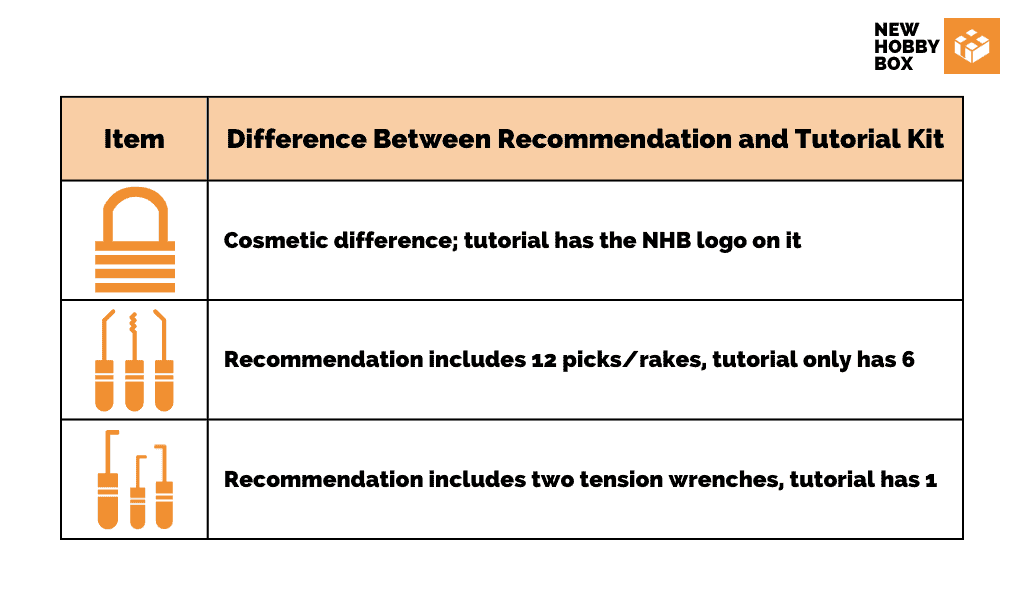
And lastly, you’ll notice that we use a dictionary safe in the tutorial. We designed our kit and this tutorial to be fun, almost like a gift for someone who likes puzzles, which is why we have the lock picking kit and a dictionary safe.
The dictionary safe in this tutorial is completely optional, we just think it’s super cool and the picks work with it. The dictionary safe currently runs for $14 on Amazon.
Enough of that – let’s get into what each tool does and how to use it to pick locks.
WHAT EACH LOCK PICKING TOOL DOES

A set can contain some variety, but each tool has a unique purpose. While some of these lock picking tools can be used outside of lock picking, they are all designed specifically for lock picking.
At a minimum, you will encounter a tension wrench and a pick.
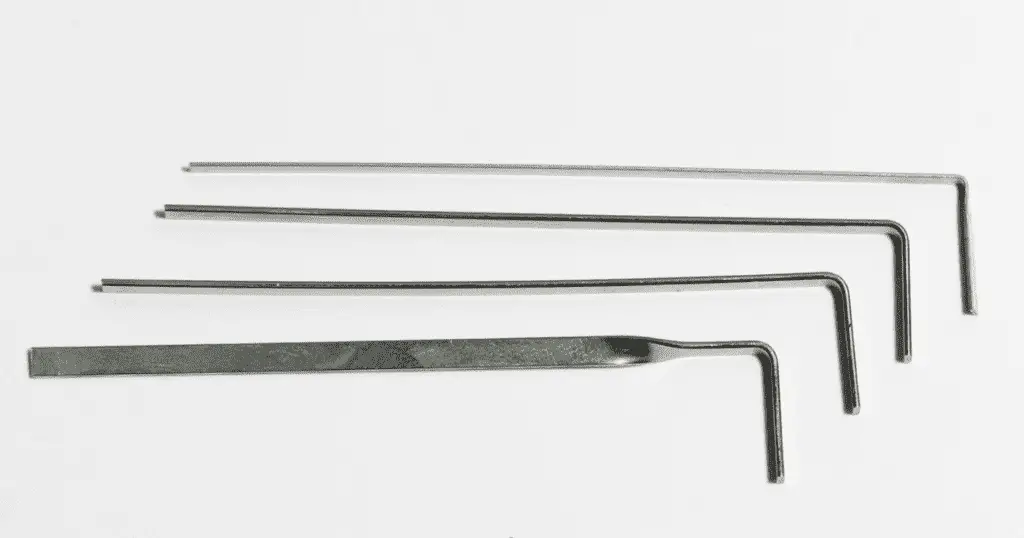
Tension Wrenches Explained
The most common tool in a lock picking set is the tension wrench, which is used to apply torque to the lock. The tension wrench is inserted into the lock and used to hold the plug in place while the pick is inserted.
Some tension wrenches are designed to fit into specific locks, while others are more universal.
Some of the most common types of tension wrenches include:
- Straight tension wrench – The most basic type, the straight tension wrench is a simple L-shaped piece of metal. It is inserted into the bottom of the keyway and used to apply torque to the plug.
- Offset tension wrench – An offset version is similar to a straight one, but with a slight offset in the L-shape. This offset allows for more precision when applying torque to the plug.
- Twist tension wrench – A twist tension wrench is similar to a straight one, but with a twist in the handle. This allows for more torque to be applied to the plug.
- Double-sided tension wrench – This aptly named tool has functionality on each side of the handle.
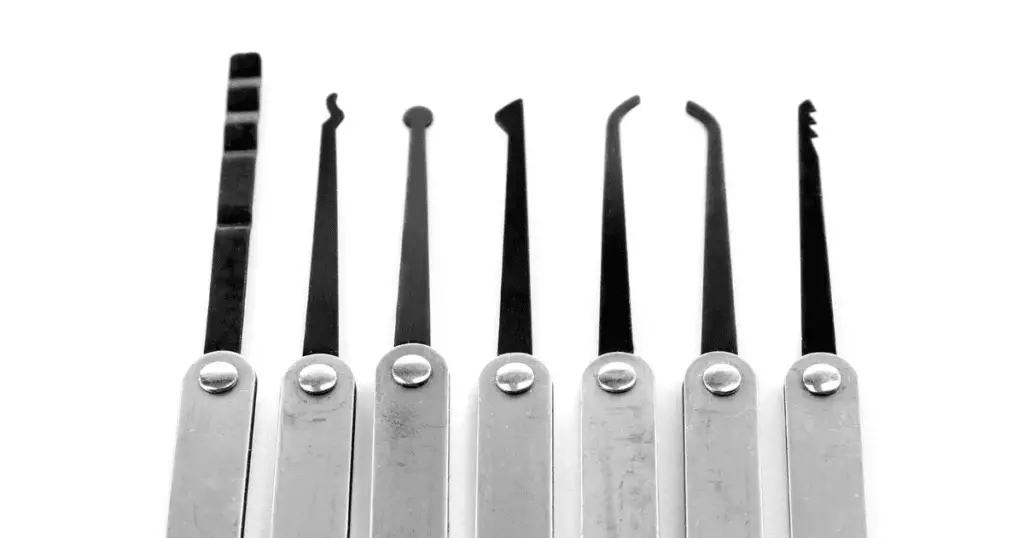
Picks and Rakes Explained
The next most common tool is the pick, including hooks/rakes, which is used to manipulate all the pins inside the lock. There are so many varieties, each built to solve a unique challenge.
- Small hook – A small hook is designed to lift the pins up one at a time.
- Large hook – Same concept as small hook, but gives a larger reach and is ideal for a larger tumbler lock.
- Single ball – The ball pick is used in locks that have a disc or wafer, which can be moved regardless of its direction.
- Double ball – Same concept as a single ball – grab this tool when the single ball isn’t doing the trick
- Small half diamond – The small half diamond pick is used for picking up pins with little variation. If you have big lengths, then go ahead and use the hook!
RAKES
Rakes are a type of pick – and they are primarily used to hack your way to a picked lock quicker. In the image above, it is the second from the left. No guarantees obviously, but these are what we use when we need to move quickly or just find the lock too challenging.
- Snake (C rake) – The rakes are the best hook for when you want to get more than one pin in a line. They generate even movement and can be jiggled or picked with heavy tension, allowing them to put up some resistance so that your bait doesn’t just fly away!
- Snake (W rake) – The same idea as the C rake, but just even more jagged edges applied.
Alright, we have a baseline on the tools – to use a lock picking set effectively though, you need to have a good understanding of how locks work.
HOW LOCKS AND PICKS WORK
When I first started learning to pick locks, this gif was very helpful in wrapping my mind around how a lock works, especially as it relates to a key.
But there are far more nuances to it than just this, and that’s all thanks to how many types of locks there are.
Different Types of Locks
So many types of locks out there – but these are a few that you encounter daily.
- Pin cylinder locks – The most common type of lock, these use pins of varying lengths to ensure that the correct key is being used. (This is the type of lock this tutorial focuses on.)
- Lever locks – Lever locks are less common than pin cylinder locks, but you may encounter them in some older buildings. Lever locks use a series of levers that must be raised to the correct height for the plug to turn.
- Wafer locks – Wafer locks are similar to pin cylinder locks, but use wafers instead of pins. Wafers are flat discs that must be aligned in the correct position for the plug to turn.
How a Key Opens a Lock
The shape of a key is dictated by the shape of all the pins in the lock. To open a lock, all you need to do is insert a key that has the same shape as the pins. I know, crazy, right? (That’s sarcasm)
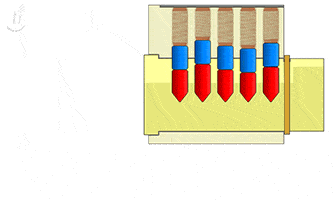

When the lock corresponding to that key is turned, the plug (which contains the pins) will rotate. This in turn will allow the driver pins to fall into the shear line and align with the keyway, which allows the plug to be rotated and the lock to be opened
It’s a little harder than just sticking every pin halfway up though. The same way a key has different heights along with it, the pins have their break at different heights.
When picking a lock you are essentially guessing the height of each pin until it clicks into place as shown below.
How a Lock Opens and Closes
The above section covers how a lock is opened with the correct key, but how does the lock close? That’s where the spring comes in.
As you can see in the gif below, when the plug is rotated, the driver pins fall into the shear line and align with the keyway. This allows the plug to rotate.
When the plug is rotated, the cam on the back of the plug pushes on the tailpiece, which in turn pushes on the latch bolt and opens the door.
SECURITY FEATURES OF LOCKS
To make lock picking more difficult, locksmiths have come up with a variety of security features that can be added to locks.
Some of these features include:
- Pins with spools or serrated pins
- Mushroom pins
- Security pins
- Bitted keys
- Key control
With practice locks, you can learn how to pick any type of lock, no matter how complex the security features may be.
HOW TO PICK A LOCK AS A HOBBY
1. Select the Lock You Want to Pick
When you’re picking a lock, you want to make sure that you have the right tools for the job, but if you are a beginner who is just trying to learn how to pick a recreational lock, you’ll want to choose the easiest option. And typically, this will be one of your own locks around your house.
If you are using the transparent lock we used, that’s great. It’s an easy practice lock to get a feel for the pins. It allows you visually understand what the pins are doing, but the key will be learning how to feel what they are doing.
It’s best to start simple; I would recommend standard pin tumbler locks. These are the most common type of locks, and they can be found on everything from doors to cabinets to safes. Such as the dictionary safe that we used.
Standard pin tumbler locks have two main parts: the plug and the keyway.
The plug is the part of the lock that you insert the key into, and the keyway is where you insert the tension wrench and pick.
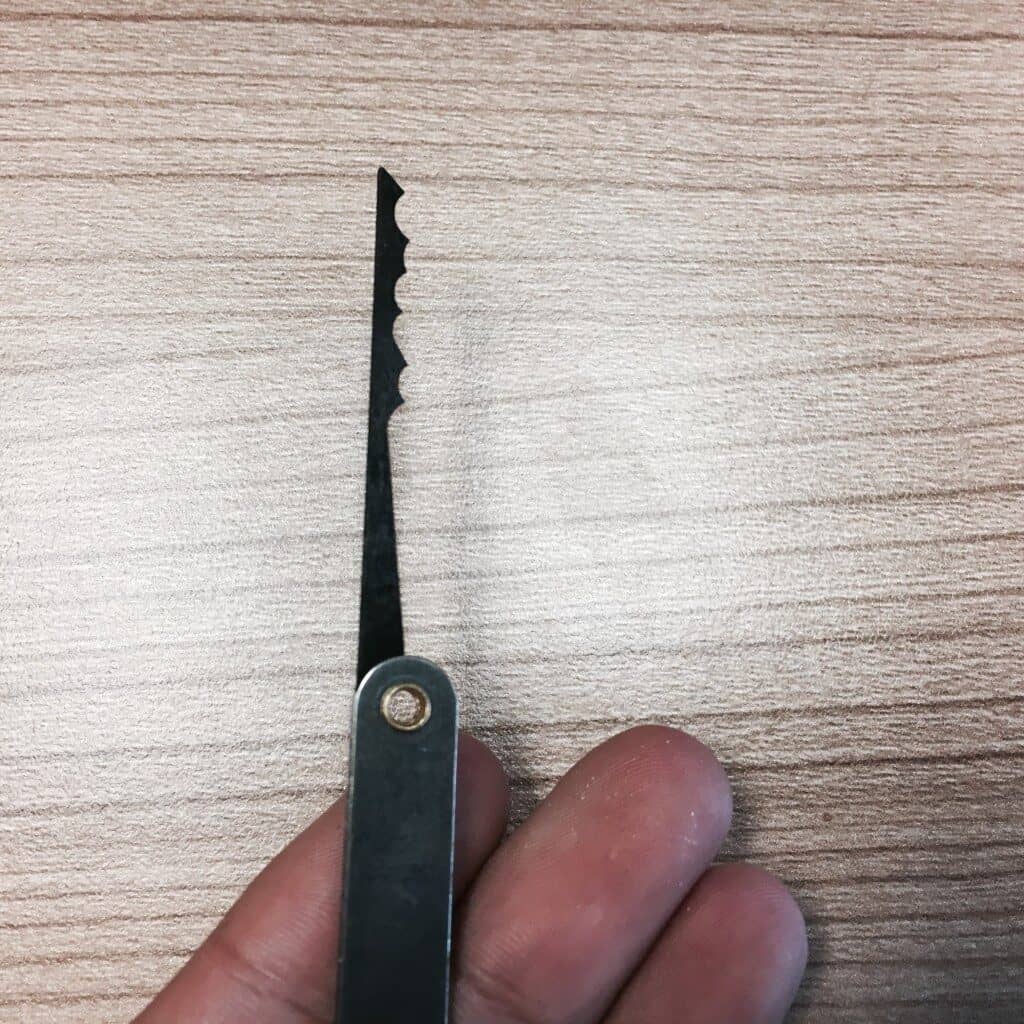
2. Select Tension Wrench and Pick/Rake
Remember, your tension wrenches are the L-shaped tools that you’ll use to apply pressure to the lock, while the pick set is used to manipulate the pins inside the lock.
I recommend using the rake (wave-shaped pick pictured above) if you are using a basic pin tumbler lock. It’s not the cleanest way to do this, but it’s easy for a simple lock.
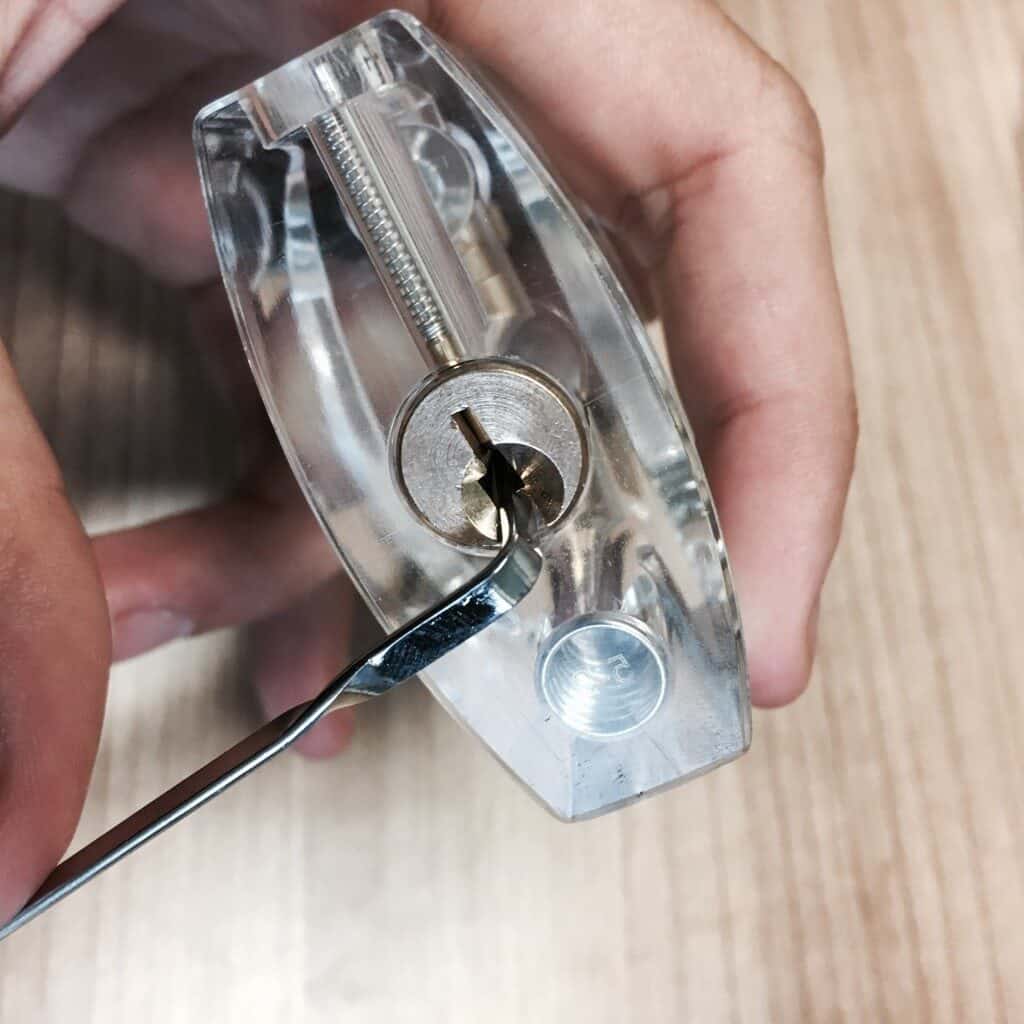
3. Insert Tension Wrench
Once you have your tools, insert the tension wrench into the lock and apply pressure. Be cautious to not apply too much pressure – there’s a fine line in the proper amount.
The goal is to keep the pins in place while you use the pick to move them up and down.
4. Gently Insert Pick or Rake
With the tension wrench in place, gently insert the pick into the keyway and feel around for the pins. The reason for this is that you want to avoid pushing the pins too hard because this can cause them to get stuck.
5. Move First Pin – Scrape Pins
Once you’ve found the first pin, use the pick to move it up and down.
I prefer to do a technique called “scraping the pins,” which means that you don’t try to push or pull the pins, but rather you use the pick to lightly scrape them. This is best applied to a rake.
That way you will get 1 or 2 right off the bat without having to work too hard. When you get a pin you will feel a very small click, which means it’s stuck – which is good.
I’ve found that I get the best results when I start at the back pin and work my way forward.
Make sure you continue to apply pressure the whole time though so the pin does not fall back down!
6. Repeat With Second Pin, and So On.
Once you’ve found the first pin, use the pick to move on to the next one. That is, move further away from yourself since the first pin is closest to you.
Repeat this process until all of the pins are in the correct position – aka clicked in place.
7. Turn Tension Wrench
Once you have all of the pins in place, the torque from the tension wrench on the cylinder will spin it open, and voila! You’ve officially picked a lock!
If you’re using the clear lock or any sort of lock that you can see what’s going on, try it with your eyes closed at a certain point.
Once you get that, move on to padlocks you have lying around the house, bedroom doors or the locked dictionary we sent.
With a little practice, you’ll be able to pick a lock like a pro. Below are some tips and reminders to keep top of mind.
TIPS FOR HOW TO PICK A LOCK
1. Apply the Right Amount of Pressure
When you are first starting, it is important to apply the right amount of pressure. If you apply too much pressure, you can push the pins out of place and make it difficult to open the lock.
A light touch is key when manipulating the pins – but also still making sure some pressure is present. I know, it’s a delicate dance between too much or too light pressure, but that’s what practice is for.
2. Don’t Overuse the Tension Wrench
This can also cause the pins to move out of place and make it difficult to open the lock. The tension wrench is key (no pun intended) in applying the right amount of pressure to the plug while you are picking the pins.
3. You May Be Using the Wrong Lock
If you’re a beginner, it’s best to start with a simple pin tumbler lock as we talked about earlier. These are the most common type of locks, and they can be found on everything from doors to cabinets to safes.
Once you’ve mastered the basics, you can move on to more advanced locks. If you are really struggling with your lock, make sure you are not doing some advanced lock.
4. Use the Correct Tools
You’ll need a tension wrench and pick set to pick a lock. Yes, I know, nothing crazy here, but it’s tough to fake it with anything else.
You might be able to get by with a paperclip or bobby pin in a pinch, but only for the most basic of basic locks, unless you’re MacGyver. For the most part, you’ll want to use the proper tools.
5. Follow the Correct Sequence
Make sure you insert the tension wrench into the lock and apply pressure before you use the pick to manipulate the pins. If you do not do this in the right order, it will be very difficult to open the lock – or impossible.
If you are interested in other ways to pick locks (like a bump key or paperclip) here are a couple of videos I found super interesting and fun to try. Enjoy!!
The more locks you can get the more natural it will feel… Let us know if you have any specific questions about the tools or methods we’ve talked about in the comments below.
As always, thanks for trying a new hobby with us. If you want to stay up to date with our latest how-tos, be sure to join our newsletter.

